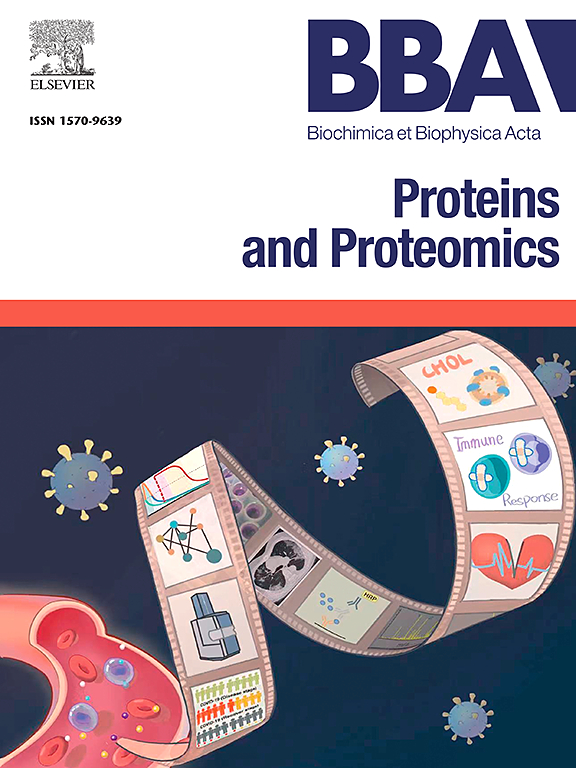Biophysical analysis of SECIS binding protein 2 (SBP2) from Naegleria gruberi
IF 2.3
4区 生物学
Q3 BIOCHEMISTRY & MOLECULAR BIOLOGY
Biochimica et biophysica acta. Proteins and proteomics
Pub Date : 2025-04-26
DOI:10.1016/j.bbapap.2025.141075
引用次数: 0
Abstract
The Selenocysteine (Sec - U) biosynthesis pathway is present in eukaryotes and prokaryotes, in which its incorporation is directed by the stop codon UGA and the structural mRNA element named Sec Insertion Sequence (SECIS) that contain an essential kink-turn motif recognized by specific RNA-binding proteins. SBP2 is the key player in the interaction with the SECIS element in eukaryotes, and it is essential for the biosynthesis pathway. Free-living amoebas are part of the Heterolobosea phylum, and several species, including Naegleria fowleri, are known human pathogens. In 2013 it was reported that Naegleria gruberi (NgSBP2), which is non-pathogenic, had a divergent SBP2 sequence and all the genes essential for Sec synthesis. The identity of NgSBP2 is confirmed experimentally and its binding affinity to the SECIS element is demonstrated. The N-terminal and the C-terminal domains (NgSBP2-NT and NgSBP2-CT, respectively) of NgSBP2 contain disordered regions, particularly in the N-terminal domain. The SECIS element is bonded to NgSBP2-CT, which results in a decrease in the disordered sequence of the domain, and the NgSBP2-NT domain interacts with NgSBP2-CT.SECIS complex, as we present here. The findings reveal the molecular interaction patterns underlying the selenocysteine incorporation pathway in an early-branching eukaryote, which is influenced by multiple protein-RNA interactions.
格氏耐格氏菌SECIS结合蛋白2 (SBP2)的生物物理分析
硒代半胱氨酸(Sec - U)生物合成途径存在于真核生物和原核生物中,其结合由终止密码子UGA和Sec插入序列(SECIS)结构mRNA元件指导,该元件包含一个被特定rna结合蛋白识别的必要的扭曲转基序。在真核生物中,SBP2是与SECIS元件相互作用的关键分子,对生物合成途径至关重要。自由生活的阿米巴原虫是异虫门的一部分,包括福氏奈格里原虫在内的几种阿米巴原虫是已知的人类病原体。2013年有报道称,一种非致病性的gruberi Naegleria (NgSBP2)具有不同的SBP2序列和合成Sec所需的所有基因。实验证实了NgSBP2的身份,并证明了其与SECIS元件的结合亲和力。NgSBP2的n端结构域和c端结构域(分别为NgSBP2- nt和NgSBP2- ct)含有无序区域,特别是在n端结构域。SECIS元件与NgSBP2-CT结合,导致结构域无序序列减少,NgSBP2-NT结构域与NgSBP2-CT相互作用。SECIS复合体,就像我们在这里展示的。这些发现揭示了早期分支真核生物中硒代半胱氨酸掺入途径的分子相互作用模式,该途径受多种蛋白质- rna相互作用的影响。
本文章由计算机程序翻译,如有差异,请以英文原文为准。
求助全文
约1分钟内获得全文
求助全文
来源期刊
CiteScore
8.00
自引率
0.00%
发文量
55
审稿时长
33 days
期刊介绍:
BBA Proteins and Proteomics covers protein structure conformation and dynamics; protein folding; protein-ligand interactions; enzyme mechanisms, models and kinetics; protein physical properties and spectroscopy; and proteomics and bioinformatics analyses of protein structure, protein function, or protein regulation.

 求助内容:
求助内容: 应助结果提醒方式:
应助结果提醒方式:


